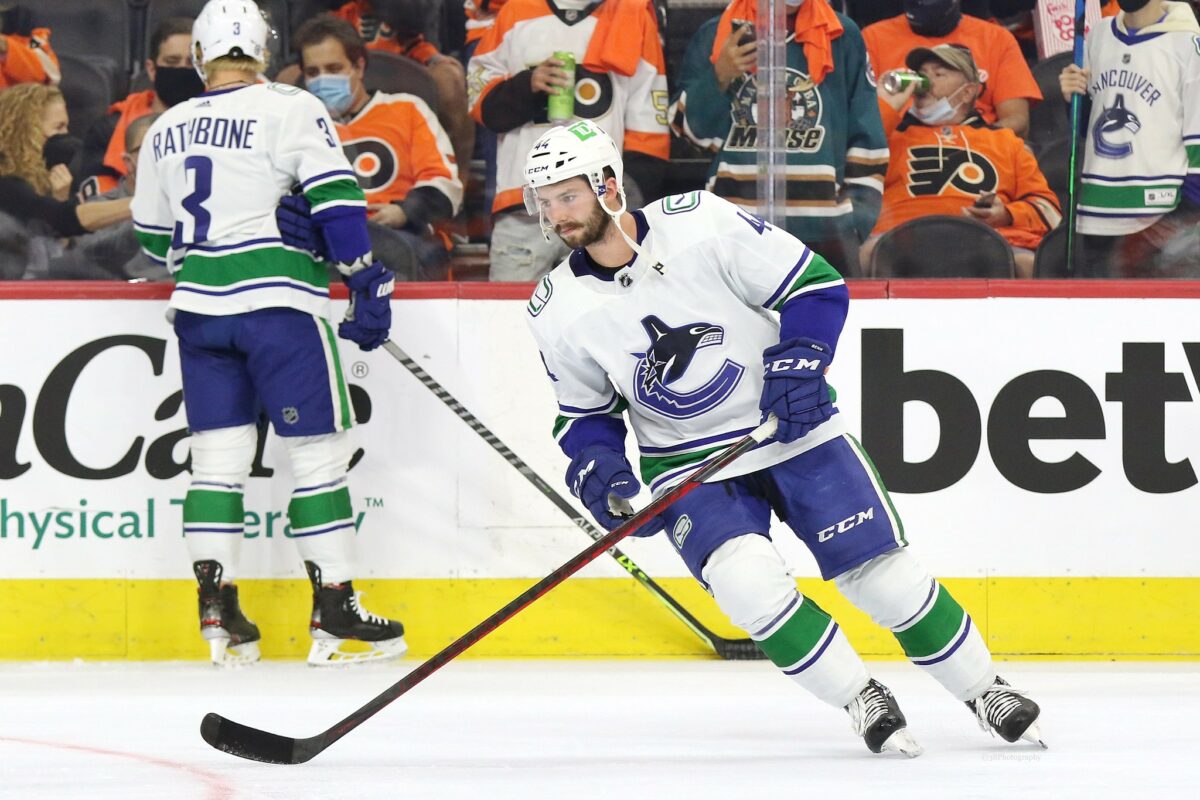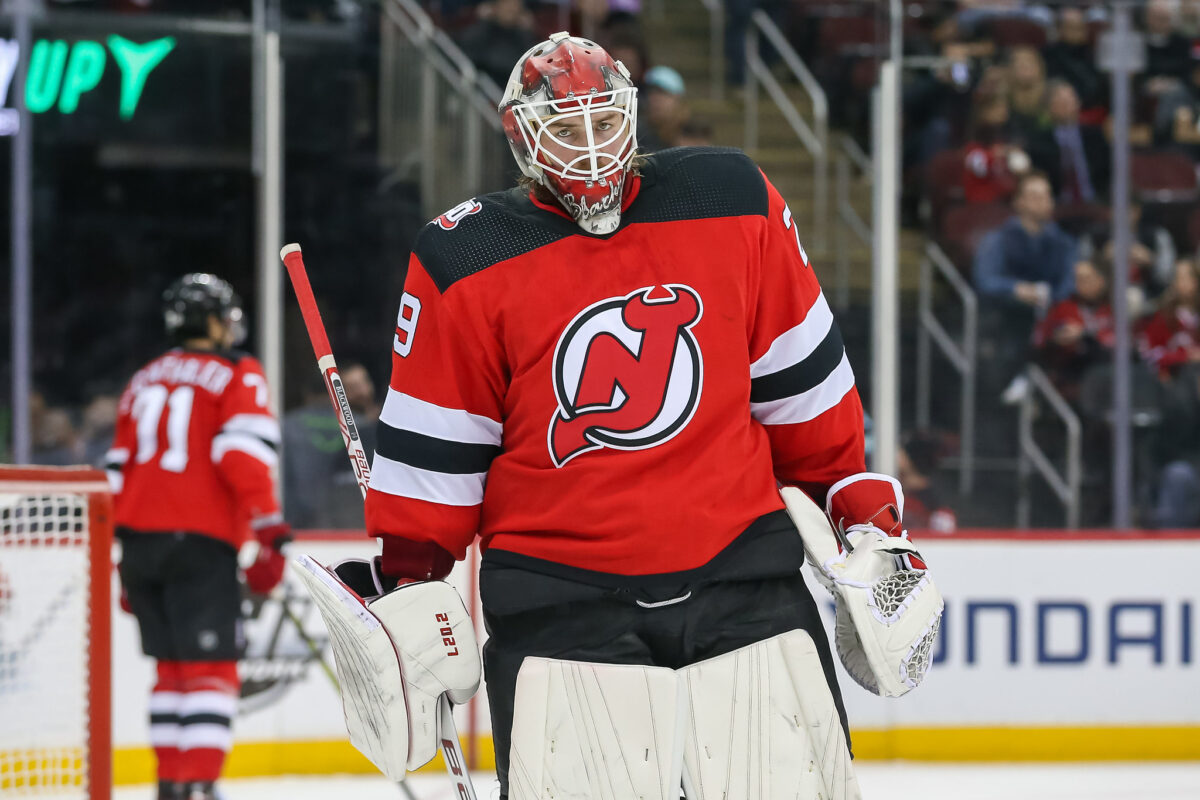The NHL offseason can feel like a chaotic rush. Teams are constantly making signings and trades, deciding where to send key prospects, and getting their rosters into focus for the upcoming season. Even a team that did not make tons of moves, such as the San Jose Sharks, can be difficult to analyze. The 2023-24 lineup looks very different from last season’s, and individual transactions can disappear from view as a result. But now that the offseason is winding down, and San Jose seems to be done making moves, we can all take a breath and break them down one by one. Here are five key decisions they made in the offseason, analyzed and graded.
Signing Kyle Burroughs
The longest contract San Jose gave out this offseason was the three-year, $3.3 million deal for former Vancouver Canucks defenseman Kyle Burroughs. Signing a player like him tracks with the franchise’s larger plans. The Sharks have struggled defensively over the last few seasons, some of which can be attributed to rosters heavy on defensemen who were skilled on offense but not as strong on the other side of the ice. Burroughs is a defensive-minded blueliner who is certainly capable of helping the Sharks lower their goals allowed totals.

The question marks around the signing relate to Burroughs’ lack of NHL experience. Although he is 28 years old and has been playing professional hockey for almost a decade, he has appeared in just 95 NHL games. The Sharks are counting on him to play a much larger role than he has played in his career thus far. Asking a player with fewer than 100 games of NHL experience to be a top defensive defenseman is a sizable risk.
Thankfully for the Sharks, their status as a rebuilding franchise will allow Burroughs to develop, play through mistakes, and correct his negative tendencies such as his frequent trips to the penalty box. In total, Burroughs and San Jose seem like a solid match.
Final Grade: B
Signing Mackenzie Blackwood
While Burroughs may have received the Sharks’ longest contract, the most expensive went to goalie Mackenzie Blackwood’s two-year, $4.7 million deal. In a vacuum, the move makes a lot of sense for both sides. He was one of the top goalie prospects at the 2015 NHL Entry Draft and was selected in the second round by the New Jersey Devils. Although he was their primary goaltender from 2019 to 2021, his numbers have taken a sharp decline over the past few seasons and he fell out of favor with the Devils, relegated to a third-string role. He clearly needed a change of scenery as he entered restricted free agency, and the Sharks needed goalies. San Jose could afford to bring in a goalie like Blackwood, who might need time to regain his footing as he tries to turn his career around. They also made a logical move by trading for his negotiating rights before signing him.

In the context of the Sharks’ larger goalie picture, however, the move is a bit less of a sure thing. In the post-Martin Jones era, their netminders have been a constant stream of stopgap measures — Devan Dubnyk, Josef Korenar, Adin Hill, James Reimer and Kaapo Kahkonen, to name a few. Of them, only Korenar ever felt like a potential permanent solution, and even that didn’t last very long. Given that Blackwood has spent more of his career as a backup than a starter, this deal could easily become yet another example of the Sharks kicking the goaltending can down the road.
The success of the Blackwood signing will largely be determined by whether or not he eventually falls into this category. If he becomes the starter in net for several seasons — which certainly could happen — then the move obviously becomes a wild success. Until then, it’s unfortunately too easy to see him as more goalie filler.
Final Grade: B-
Trading for Anthony Duclair
The Sharks made their first notable trade of the offseason when they dealt Steven Lorentz and a fifth-round pick to the Florida Panthers in exchange for forward Anthony Duclair.
While hardly a blockbuster, this was a great trade for the Sharks thanks to the amount of flexibility it provides them. Duclair is on an expiring contract, and has skills that could make him attractive to contending teams at the trade deadline. On the other hand, his journeyman status means he may be looking for a more permanent home, and San Jose can definitely provide that. But whether he gets flipped for assets or stays with the Sharks for several seasons, he can have a sneakily significant impact on the future of the franchise.
Related: Sharks Already Preparing for 2024 Trade Deadline
While it was difficult to part with Lorentz and his improving ability as a checking forward, bringing in Duclair is a clear win for San Jose.
Final Grade: A-
Signing Filip Zadina
After much deliberation over his potential destination, Filip Zadina signed with San Jose in July on a one-year deal. While several fanbases wanted their teams to take a flier on the former highly touted prospect, the Sharks snagged him, and in the process made their best move of the entire offseason.
Zadina struggled to live up to expectations as a member of the Detroit Red Wings, and now gets a chance to reset his career in San Jose. He won’t face nearly the same amount of pressure he did in Detroit, and will be given the freedom to develop his game and see if he can find the skill that made him the sixth overall draft pick in 2018.
From San Jose’s perspective, the Sharks can give him lots of playing time to make their own evaluations of him. Not only is the deal for just one season, but it also ends with Zadina entering restricted free agency, giving the team a lot of control over his next contract. If he returns to his top-prospect form, the Sharks can make him a key part of the future, and if he doesn’t, they can simply write it off as an unsuccessful but worthwhile experiment.
The Sharks were the perfect team for Zadina, and Zadina was the perfect player for the Sharks. Thankfully, they teamed up for a perfect deal.
Final Grade: A
Trading Erik Karlsson
The Sharks made their final and biggest notable transaction of the offseason by dealing Norris Trophy winner Erik Karlsson to the Pittsburgh Penguins in a three-team trade that also involved the Montreal Canadiens.

The Sharks’ return haul in the trade was solid, but it comes with some uncertainties. They received three players and a 2024 first-round pick, but also retained just 13 percent of Karlsson’s salary when some pundits expected them to retain 25 or even 50 percent of the contract. Essentially, Sharks general manager Mike Grier had a choice: take on more of Karlsson’s contract and gain more assets, or shed more salary and get fewer assets. He chose the latter route.
While this decision is understandable given San Jose’s recent cap crunch, it means that the Karlsson trade’s success is largely yet to be written. The Sharks now have an extra $10 million in cap space for each of the next four seasons and must spend it wisely. A trade that provides a team with a bunch of yet-to-be-spent money can’t be given a great grade or a poor grade.
So while it’s easy to wish that the Sharks had added more assets, the cap space they obtained could pay off in a big way if the front office makes the right moves.
Final Grade: B
Sharks Gearing Up for the Future
All five of these moves have one thing in common: they were made not to win in 2023-24, but a few seasons from now.
The Sharks are aware that they’re not ready to contend this season or even next. Instead, they are using signings and trades to lay the groundwork for a future in which they return to the contending ways that made them one of the league’s premier franchises for so long.
